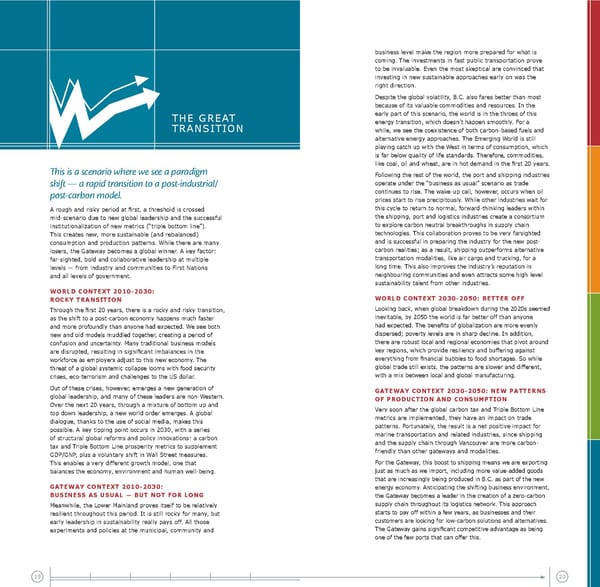business level make the region more prepared for what is coming. the investments in fast public transportation prove to be invaluable. even the most skeptical are convinced that investing in new sustainable approaches early on was the right direction. despite the global volatility, b.c. also fares better than most because of its valuable commodities and resources. in the the great early part of this scenario, the world is in the throes of this transition energy transition, which doesn’t happen smoothly. For a while, we see the coexistence of both carbon-based fuels and alternative energy approaches. the emerging World is still playing catch up with the West in terms of consumption, which is far below quality of life standards. therefore, commodities, like coal, oil and wheat, are in hot demand in the first 20 years. This is a scenario where we see a paradigm Following the rest of the world, the port and shipping industries shift — a rapid transition to a post-industrial/ operate under the “business as usual” scenario as trade post-carbon model. continues to rise. the wake-up call, however, occurs when oil prices start to rise precipitously. While other industries wait for A rough and risky period at first, a threshold is crossed this cycle to return to normal, forward-thinking leaders within mid-scenario due to new global leadership and the successful the shipping, port and logistics industries create a consortium institutionalization of new metrics (“triple bottom line”). to explore carbon neutral breakthroughs in supply chain this creates new, more sustainable (and rebalanced) technologies. this collaboration proves to be very farsighted consumption and production patterns. While there are many and is successful in preparing the industry for the new post- losers, the gateway becomes a global winner. a key factor: carbon realities; as a result, shipping outperforms alternative far-sighted, bold and collaborative leadership at multiple transportation modalities, like air cargo and trucking, for a levels — from industry and communities to First nations long time. this also improves the industry’s reputation in and all levels of government. neighbouring communities and even attracts some high level sustainability talent from other industries. World context 2010-2030: rocky trAnsition World context 2030-2050: Better off looking back, when global breakdown during the 2020s seemed Through the first 20 years, there is a rocky and risky transition, as the shift to a post-carbon economy happens much faster inevitable, by 2050 the world is far better off than anyone and more profoundly than anyone had expected. We see both had expected. The benefits of globalization are more evenly new and old models muddled together, creating a period of dispersed; poverty levels are in sharp decline. in addition, confusion and uncertainty. Many traditional business models there are robust local and regional economies that pivot around key regions, which provide resiliency and buffering against are disrupted, resulting in significant imbalances in the workforce as employers adjust to this new economy. the everything from financial bubbles to food shortages. So while threat of a global systemic collapse looms with food security global trade still exists, the patterns are slower and different, crises, eco-terrorism and challenges to the us dollar. with a mix between local and global manufacturing. out of these crises, however, emerges a new generation of gAteWAy context 2030-2050: neW pAtterns global leadership, and many of these leaders are non-Western. of production And consumption over the next 20 years, through a mixture of bottom up and Very soon after the global carbon tax and triple bottom line top down leadership, a new world order emerges. a global metrics are implemented, they have an impact on trade dialogue, thanks to the use of social media, makes this patterns. Fortunately, the result is a net positive impact for possible. a key tipping point occurs in 2030, with a series marine transportation and related industries, since shipping of structural global reforms and policy innovations: a carbon and the supply chain through Vancouver are more carbon- tax and triple bottom line prosperity metrics to supplement friendly than other gateways and modalities. GDP/GNP, plus a voluntary shift in Wall Street measures. this enables a very different growth model, one that For the gateway, this boost to shipping means we are exporting balances the economy, environment and human well-being. just as much as we import, including more value-added goods that are increasingly being produced in b.c. as part of the new gAteWAy context 2010-2030: energy economy. anticipating the shifting business environment, Business As usuAl — But not for long the gateway becomes a leader in the creation of a zero-carbon Meanwhile, the lower Mainland proves itself to be relatively supply chain throughout its logistics network. this approach resilient throughout this period. it is still rocky for many, but starts to pay off within a few years, as businesses and their early leadership in sustainability really pays off. all those customers are looking for low-carbon solutions and alternatives. experiments and policies at the municipal, community and The Gateway gains significant competitive advantage as being one of the few ports that can offer this. 19 20
 Monitor Deloitte - Final Report Page 67 Page 69
Monitor Deloitte - Final Report Page 67 Page 69